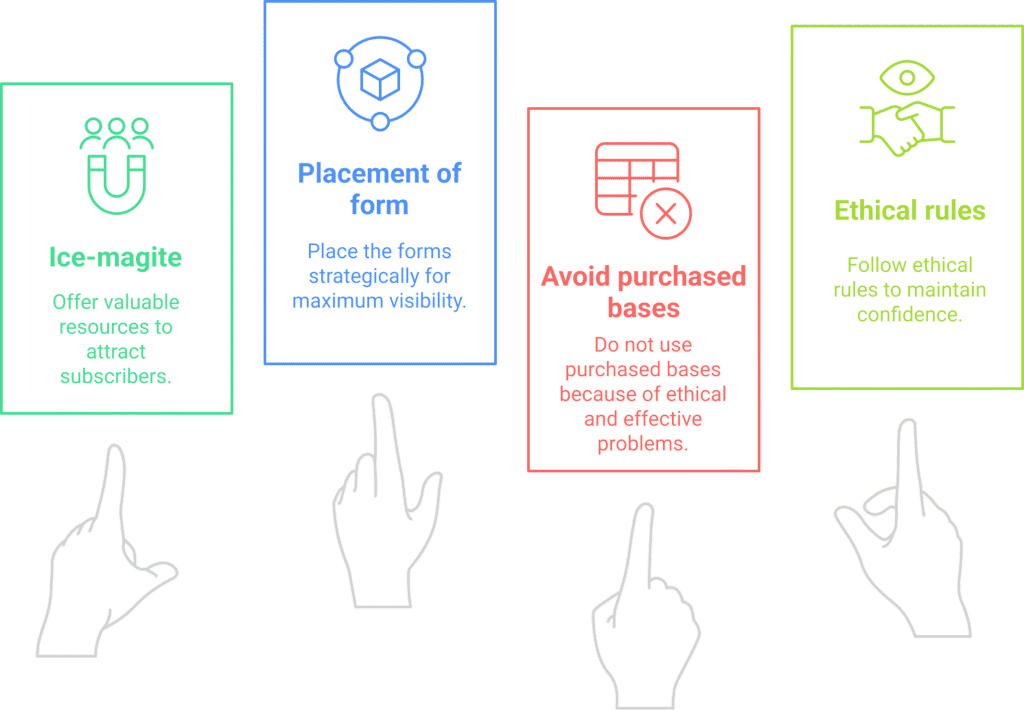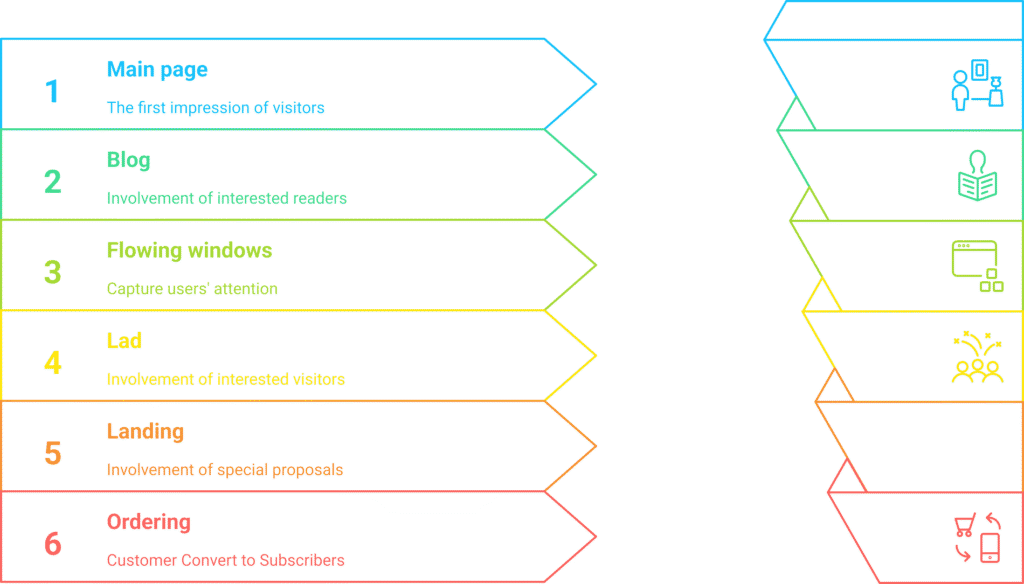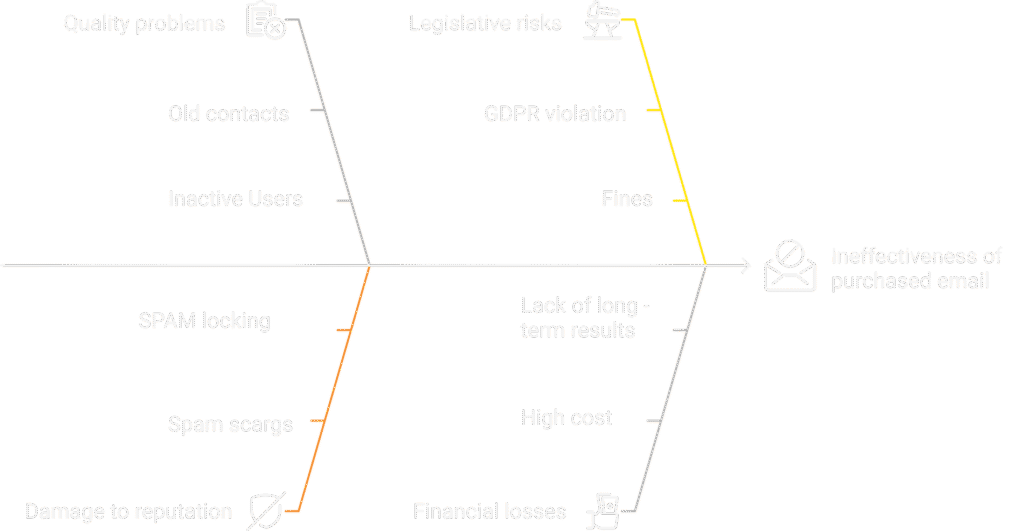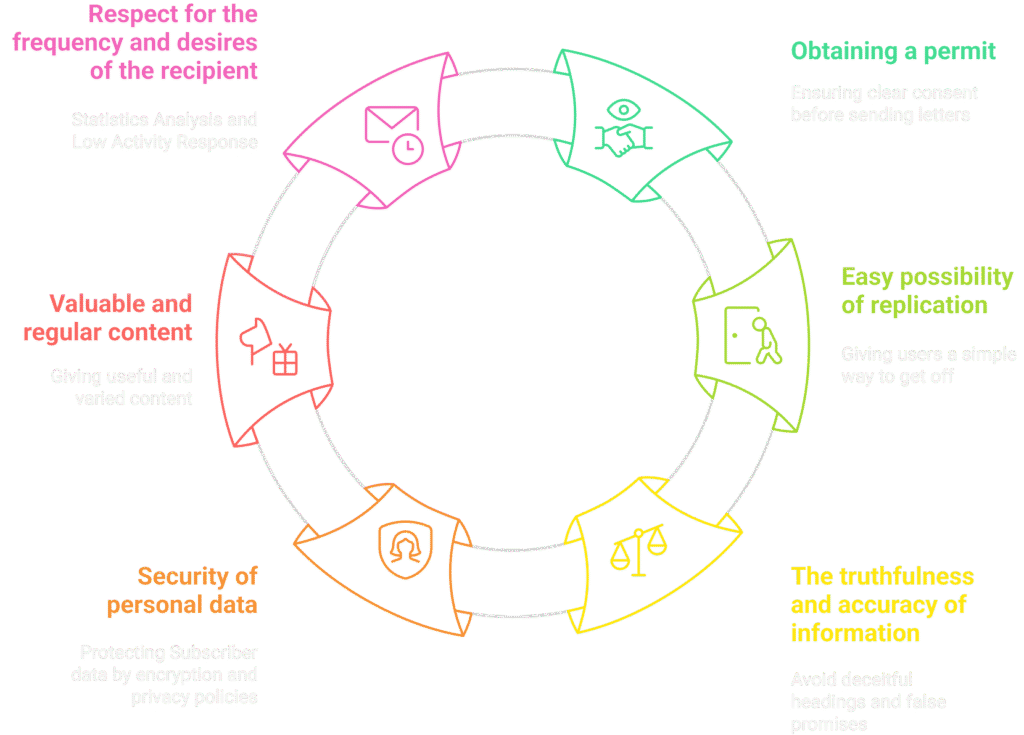Email database collection: legal methods and prohibited techniques

- Lead magnets, webinars, free materials — how to attract subscribers
- Where to place the subscription form
- Why purchased databases are a road to nowhere
- Ethics rules and recommendations

1. Lead magnets, webinars, free materials — how to attract subscribers
Building an email base is a key step in the development of any business that wants to work with a loyal audience and build long-term relationships with customers. However, the problem is that people are reluctant to leave their contacts, especially if they are not offered anything valuable in return. That is why effective methods of attracting subscribers are based on creating attractive offers that are difficult to ignore.
What is a lead magnet and why does it work?
A lead magnet is a piece of useful content or a unique offer that a person receives in exchange for their email address. It could be a checklist, a free book, a video tutorial, or even a trial of a service. The main idea of a lead magnet is to make subscribing look like an exchange that is beneficial to the user.
“People don’t want to just leave an email. They want something in return. Give them that!”
Examples of effective lead magnets:
- Checklists and guides : “10 SEO mistakes that are destroying your website”
- Free Trials : “Try our service for 14 days free”
- Discounts and bonuses : “Get a promo code for -15% when you subscribe”
- Templates : “Download a ready-made business presentation template”
- Exclusive content : “Closed Telegram channel for subscribers”
Webinars and live events
Another effective way to build a subscriber base is to host a free webinar or online meeting. This creates a sense of personal interaction and allows you to work with your audience in real time. A webinar can be either a useful lecture or a product presentation, but the main thing is to provide value, not just advertise yourself.
“Invite people not to a presentation, but to a discussion of their problems and ways to solve them. This works better than any advertising.”
How collecting email addresses through webinars works:
- The user registers through a form, specifying their email.
- Receives reminders and access to the webinar.
- After the webinar, you automatically receive additional material or a recording of the event.
- The email is stored in the database and can be used for marketing mailings in the future.
Free materials and trials
People love free stuff. That’s why free trials and demos are a great way to build a following. For example, if you’re a software developer, let people try your product before they buy. If you’re a blogger, offer an exclusive article or helpful PDF tutorial.
Importantly!
Don’t try to trick users. If you promise useful content, it should be. Otherwise, people will simply subscribe, get the file, and then unsubscribe immediately, disappointed in you.
How to make a lead magnet effective
- Segment your audience . Different people want different content. It doesn’t make sense to offer entrepreneurs “Best Dessert Recipes.”
- Make the opt-in process simple . Fewer fields in the subscription form = more subscribers.
- Design your proposal well . If it’s a PDF, make a good design, if it’s a video, record high-quality sound.
- Add calls to action (CTAs) . “Download Now,” “Join for Free” works better than just “Subscribe.”
2. Where to place the subscription form
Building an email database is only half the battle. It’s important to place your subscription form correctly so that it’s visible, convenient, and unobtrusive. The main rule is that the subscription form should look organic and not distract the user.

Key places to place a subscription form
- Home Page The home page is the first thing a visitor sees. If your content or product interests them, they are more likely to leave an email. The best option is to place the subscription form at the top of the page or in the form of a floating panel.
- Blog or informative articles People who read your blog are already interested in your topic. Add a subscription form at the end of each article, and also use popup banners that appear after a certain amount of time on the page.
- Pop-ups Dynamic pop-ups can significantly increase your follower count, but it’s important to use them wisely. The following work best:
- Windows that appear after scrolling 50% of the page
- Exit-intent pop-up (when the user is about to close the tab)
- Timer pop-ups (30-60 seconds after entering the site)
- Site Footer Many people scroll all the way to the bottom of a page before making a decision. Placing a form in the footer allows interested visitors to subscribe without any fuss.
- Landing pages and promotions If you have a special offer (such as a discount or a free course), create a separate landing page with a clear call to action.
- Checkout (order page) If the user purchases something, add a checkmark next to the email input form to “Receive useful materials.”
- Social media and advertising Use a link to the subscription form in your Instagram bio, Facebook groups, or ads.
“When a subscription form is part of a user’s natural journey, its effectiveness increases exponentially.”
Properly placing your opt-in form on your website or app is crucial to the effectiveness of your email subscription campaign. A well-placed opt-in form can significantly increase your subscriber acquisition rate, while poorly placed opt-in forms can be ineffective or even turn off potential customers.
Basic principles for placing a subscription form:
- Simplicity and visibility
The subscription form should be easily visible, but not intrusive. It is important that it is not too aggressive for users. It makes sense that the form should be visible as soon as a person enters the site, but not demand too much attention from the visitor, for example, again, without blocking other important elements. A natural place for such a form is at the top of the page, from where it will instantly attract attention, as well as at the bottom of the page or in its sidebar for those who are ready to subscribe to it after they have familiarized themselves with the content on the page. - Home Page Form
One of the most obvious places to place a subscription form is the home page of your site. It should fit into the overall design and structure of the site. Banners or pop-ups that appear a few seconds after the user enters the site work well here. Example:
For example, if your site has a lot of content or resources placed on the home page, you can add a block with a request to subscribe to an email newsletter that stands out from the rest of the content, but does not overload the visual design of the page. - Footer Form (Bottom of Site)
All visitors who have reached the bottom of your site are already interested users. Placing your subscription form at the very bottom of your site is a strategically good place for those who are, in fact, ready to subscribe because they have already familiarized themselves with your content or product. It is also a great option for content-rich sites where you don’t want to clutter the main page with too many elements. Choosing to add the form specifically in the footer allows you to make it accessible without sacrificing user experience. - Blog or Article Form
Blogs are great places to attract new subscribers. If you have a blog, write a clear call to action at the end of each article. The text can be as simple as: “Sign up for our updates to get more useful articles like this delivered straight to your email.” It’s important to place the subscription in the right strategic places: both in the middle of the content and at the end. - Form on Contact or About Us Pages
Sign-up forms work really well on pages where users typically look for more information about you or your services. If a user has landed on your Contact or About Us page, they probably already have some interest in your business and are ready to learn more. - Pop-up form
The use of pop-ups is a controversial issue, as they can be both useful and intrusive. The decision to use pop-ups should be well-founded. It is best to place pop-ups after the user has been on the site for a certain period of time, or when they are about to leave the page. This type of form can be configured to appear after a certain period of time on the page or even when the user scrolls down the page. - Integration with other channels
For example, you can embed subscription forms into social media so that users can subscribe to your newsletter not only through your website, but also through Facebook or Instagram. This will allow you to collect more subscribers, especially among people who do not want to leave their social media profiles, but are still interested in receiving your content or offers. - Subscription form on landing pages
Landing pages are often used for targeted promotions or marketing campaigns. On such pages, the subscription form can be the main element and even the main call to action. In this case, the subscription form acts as the main lead collection tool, and it should be as simple as possible, with a clear and understandable request for subscription.
Key points to consider when placing a subscription form:
- Easy to fill out. Signing up should be a simple and quick process for the user. Don’t overload the form with unnecessary fields. Ideally, just providing an email is enough.
- Visibility, but not obtrusiveness. Don’t make your subscription form too aggressive or intrusive. Leave room for users to make choices.
- Mobile-friendly. Forms should be easy to fill out from any device, so it’s important that the form is mobile-friendly.
- Clear call to action: Use a clear and concise call to action that encourages users to subscribe. It’s important to communicate why subscribing is beneficial for them (e.g., “get helpful tips,” “free access to content”).
Choosing the right placement for your opt-in form is not only a design issue, but also a practical one that impacts your conversions. It’s important to constantly test and analyze different opt-in form placement options to choose the one that delivers the best results for your target audience.
3. Why purchased databases are a road to nowhere
In many cases, when a business is faced with the need to quickly gain a large number of subscribers for an email newsletter, it can be tempting to purchase a ready-made contact database. However, using purchased email databases is not only inefficient, but can also seriously damage your reputation, as well as lead to fines and problems with message delivery. Why is this so? Let’s take a closer look at this.

1. Problems with the quality of the database
One of the main problems with purchased email databases is their low quality. Most of these databases consist of contacts who are either not interested in your products and services, or are not even real. In many cases, such addresses can be old, inactive, or even fake.
How does this affect the effectiveness of the newsletter?
- Low email open rates. If you try to send your messages to addresses that are inactive or invalid, there is a high chance that your emails will not be opened or simply sent to spam. This will lead to low open rates, which is an important indicator for a successful email marketing campaign.
- Lowering your domain reputation. If you send emails to inactive or fake addresses, it can lead to your email campaign being marked as spam. This will negatively affect your reputation as a sender and may affect the deliverability of your future messages. Spam filters will automatically block your emails, making it difficult for you to reach the inbox, even for those who have voluntarily subscribed.
2. Legal implications and ethics
The use of purchased email databases often violates data protection and spam laws. Many countries, including the European Union, have strict laws regarding how and to whom marketing materials can be sent. This includes the GDPR (General Data Protection Regulation), which requires users to have explicit and informed consent to receive emails from companies.
How it works:
- If you use purchased databases without prior consent from users to receive newsletters, you are violating the law, and this may result in fines and sanctions.
- If the addresses in the database were collected without the users’ permission, your campaign is illegal and you may be punished for violating personal data protection laws.
3. There is a high chance that you will be noticed as a spammer
Spam is one of the biggest enemies of email marketing. Purchased databases are often made up of contacts who haven’t given you permission to receive emails, so you’re sending them unsolicited advertising. When you send promotional materials to such users, they’re more likely to mark your emails as spam.
Consequences of being spammed:
- Damage to sender reputation. If your emails end up in the Spam folder, your reputation as a sender decreases, and in the future it will be more difficult to deliver emails even to those who agree to subscribe. Email services such as Gmail, Outlook or Yahoo pay great attention to the reputation of the sender. If the reputation is damaged, your emails simply will not reach the Inbox.
- Reduced effectiveness of mailings. Constantly getting into spam reduces the delivery and opening rates of emails, which, in turn, can lead to significant losses for your business.
4. Purchased databases do not attract interested users
Email subscriptions should be voluntary and informed. A user who subscribes to your newsletter already has an interest in your products or services. These are people who are ready to receive your emails, so their responses and engagement in the campaign will be much better.
Purchased databases do not allow you to connect with truly interested customers. Most of the people in such databases may not be interested in your product or service at all. You will not be able to build a real connection or interaction with them. Moreover, when users receive emails from companies they do not know and are not related to, they often unsubscribe or, worse, report them as spam.
5. Misused funds
In general, buying a contact database does not provide long-term results. Instead of spending money on buying contacts, it is better to invest in building your own, high-quality email database through effective engagement strategies. Purchased databases are often expensive, and do not guarantee high engagement levels or the achievement of specific business goals.
6. How to build your own subscriber base
Instead of buying ready-made bases, focus on building your own subscriber base. This is not only more ethical, but also much more effective in the long run. There are several methods to organically acquire subscribers:
- Creating valuable content. Blogs, infographics, videos, and other resources allow you to attract subscribers to your website and motivate them to subscribe to your email newsletter.
- Using lead magnets. Offering free materials, such as e-books, guides, or checklists, allows you to attract users and get their email addresses in exchange for valuable content.
- Promotions and contests. Running promotions or contests on your website or social media is a great way to attract new followers.
Result
Purchased email databases are a road to nowhere. They don’t generate real subscribers, often violate laws, and tarnish your company’s reputation. Instead of spending money on purchasing such databases, it’s better to invest in building your own subscriber base through legal and ethical methods that will bring real value to your business and help you achieve high results in email marketing.
4. Ethics rules and recommendations
Email marketing is a powerful tool for engaging and engaging with customers, but its effectiveness and long-term success are directly dependent on how ethically you use this communication channel. Failure to adhere to ethical standards can lead to serious problems, including loss of reputation, legal consequences, and reduced campaign effectiveness. Therefore, it is important to know the basic rules of email marketing ethics and apply them to your strategies.

1. Obtaining permission is the foundation of email marketing ethics
The most important rule of etiquette in email marketing is to get your subscribers’ permission to receive your newsletter. Legislation in many countries, including GDPR in the European Union, clearly requires that you have clear and informed consent from the customer before sending marketing emails.
How it works:
- Double Opt-in: This is a standard where the user first fills out a subscription form and then receives an email with a confirmation link. This ensures that the subscription was made intentionally and without errors.
- Transparency and clarity. It is important that users know exactly what they are signing up to receive, and in what form. Use clear language and don’t hide information. If you are sending commercial emails, they should understand this.
2. Providing an opportunity to unsubscribe
If a subscriber decides to stop receiving emails, you should provide them with a simple and clear way to unsubscribe . This is also an important ethical aspect, as forcing someone to receive unnecessary emails violates their rights and can cause a negative reaction.
How to organize it:
- Easy access to the unsubscribe button. Typically, an unsubscribe button or link should be located at the bottom of each email.
- No unnecessary questions. Your unsubscribe form should not require unnecessary actions or questions. The user should not have to fill out additional forms or choose a reason for unsubscribe if they do not want to do so.
3. Accuracy and truthfulness of information
Email marketing should be based on true and reliable information . Don’t use misleading headlines, clickbait, or other manipulations to attract users’ attention. This may bring a temporary effect, but in the long run it kills trust in your brand.
How to avoid manipulation:
- Truthful email titles and subjects. The email title should clearly reflect the content of the message. If you use promises, they should be realistic and deliverable.
- Honesty in content. Avoid unfair marketing techniques. If you offer discounts or promotions, they should be real and not contain hidden conditions.
4. Ensuring the security of personal data
Email marketing ethics also mean that you protect the personal data of your subscribers. This is not only an ethical aspect, but also a legal obligation. Legislation such as GDPR and other data protection laws require that you store users’ personal data securely and not share it with third parties without their consent.
How to ensure this:
- Data encryption. It is important to use secure services to collect and store personal data of subscribers. Encrypting information ensures that the data is not accessible to unauthorized persons.
- A clear privacy policy. Your privacy policy should be clear and accessible to your subscribers. It should explain how you process their data, for what purpose, and with whom you may share it.
5. Regularity and value of content
Subscribers who voluntarily subscribe to your emails expect to receive valuable and useful content. Misusing email newsletters, constantly sending spam or the same type of content with no real value can lead to subscribers unsubscribing from your newsletter or even marking it as spam.
How to create valuable content:
- Regularity and rhythm. Try not to bore your subscribers with too many emails. It is recommended to set a certain regularity: once a week, once a month, or depending on the nature of your business.
- Variety of formats. In addition to text, add graphics, videos, infographics, and useful links to your emails. This will make your content more attractive and useful.
- Personalization. Use data about your subscribers to personalize content. Include a name, choose special offers that may be of interest to this particular subscriber.
6. Respect the recipient’s frequency and wishes
Don’t send emails to people who don’t want to receive them. If a subscriber doesn’t open your emails or marks them as spam, it’s a sign that your strategy isn’t in their best interest. Your goal is to build and maintain relationships with your subscribers, not annoy them.
How to control it:
- Analyze statistics. Constantly monitor the statistics of open emails, number of unsubscribes and interaction with content. If the indicators are decreasing, you may need to change your strategic approach to content.
- Email Frequency: Find the optimal email frequency. Subscribers may not want to receive emails every day, but they may be willing to receive one email per week or month.
Let’s summarize
Email marketing etiquette is the foundation for building long-lasting and productive relationships with your subscribers. Strict adherence to these rules helps build trust in your brand, provides legal certainty, and increases the effectiveness of your marketing campaigns. Remember that email marketing ethics is not only about how to treat your subscribers, but also about how to provide them with value and be attentive to their rights and interests.
Conclusion
Collecting and effectively using your email database is not just a matter of marketing strategy, but also a responsibility that requires taking into account ethics, legal requirements, and the desire to build long-term relationships with customers. All methods, ranging from legal approaches to attracting subscribers through lead magnets and webinars, to complex ethical issues, have one common denominator: respect your subscriber and their right to information .
To build a successful email marketing campaign, it is important to adhere to three basic principles: honesty , transparency , and respect for privacy . This will ensure not only short-term effectiveness, but also help you build a loyal audience that will become the basis for long-term relationships with your customers.
If you can build your email marketing strategy taking into account all of the above recommendations, you will not only be able to increase the number of subscribers, but also increase the level of trust in your brand, which is an important factor in creating long-term and mutually beneficial relationships with your audience.
Never forget about the ethics and legality of your actions. Buying databases or manipulating information can give an instant effect, but this is the way to losing trust and reputation. Therefore, attracting subscribers should be organic and based on their interest and desire to receive your letters. In turn, the valuable and useful content provided will ensure a high level of interaction with your audience and will be the key to successful marketing campaigns.
In conclusion, a conscientious and ethical approach to collecting an email database is the foundation for your email marketing success. Do not neglect these rules, and they will reward you with a loyal and active audience that is ready to respond to your offers and become part of your business.



